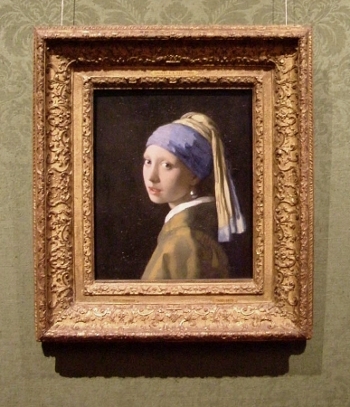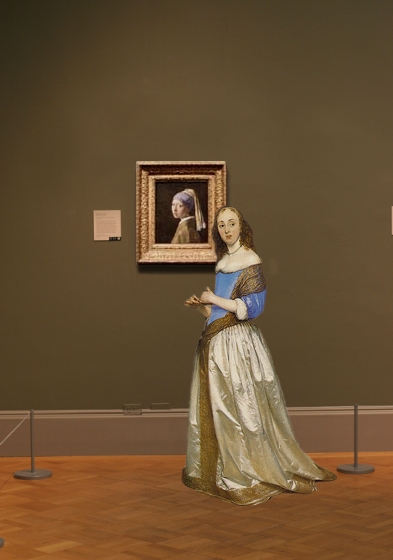Girl with a Pearl Earring
(Meisje met de parel)c. 1665–1667
Oil on canvas, 46.5 x 40 cm. (18 1/4 x 15 1/4 in.)
Mauritshuis, The Hague
inv. 670
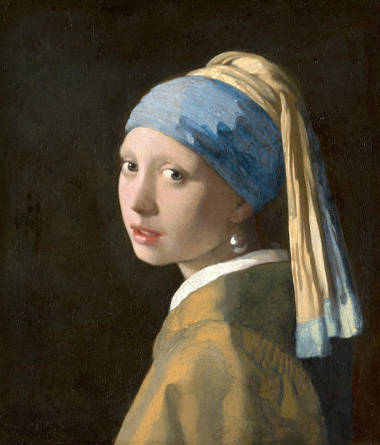
The textual material contained in the Essential Vermeer Interactive Catalogue would fill a hefty-sized book, and is enhanced by more than 1,000 corollary images. In order to use the catalogue most advantageously:
1. Scroll your mouse over the painting to a point of particular interest. Relative information and images will slide into the box located to the right of the painting. To fix and scroll the slide-in information, single click on area of interest. To release the slide-in information, single-click the "dismiss" buttton and continue exploring.
2. To access Special Topics and Fact Sheet information and accessory images, single-click any list item. To release slide-in information, click on any list item and continue exploring.
The broadly painted turban
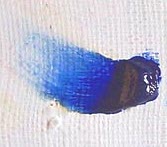
In comparison to the prevalent paint-handling techniques of its time, the expansive brushwork employed on the turban is indeed remarkable. The object's form has been distilled to two flat, elemental blue shapes. The intricate interplay of folds, a feature that likely would have been discernible in reality, has been deliberately excluded in favor of a simplified representation.

The blue section of the turban was executed using natural ultramarine—with minimal amounts of the ruby red read madder—, a notably costly pigment derived from crushed lapis lazuli imported from Afghanistan, a rare choice among Vermeer's contemporaries. The pigment's inherent chromatic brilliance is particularly evident in areas where it has been applied undiluted (mixed only with lead white), as seen in the depiction of the girl's vivid blue turban. Notably, Vermeer consistently employed this pigment even during the final years of his life, a period marked by his financial struggles due to the war with France. It is plausible that the artist's affluent patrons from Delft, Pieter van Ruijven and his wife Maria de Knuijt, might have shouldered the expense, given their close association.
The slash of white paint

This singular, audacious stroke of white impasto signifies a portion of a chemisette worn beneath the unrefined yellow ocher garment. Remarkably, an almost identical brushstroke outlines a garment donned by the subject in Vermeer's The Art of Painting. The paint of this stroke has probably undergone changes in its original nature due to prior restoration efforts, during which hot irons were utilized to reinforce the deteriorating canvas.
The painting's restoration
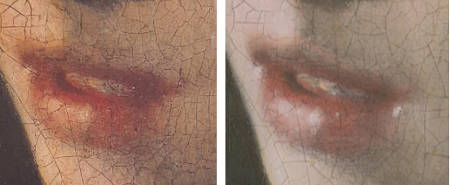
The Girl with a Pearl Earring has been treated several times since she entered the Mauritshuis collection. It underwent an extensive restoration in 1994, supervised by the Mauritshuis department of conservation. This restoration unfolded within a room outfitted with a glass wall, providing the public an opportunity to observe the restoration process. The result was a revelation of the artwork's masterful three-dimensional impact, vibrant color palette and previously concealed intricacies of the flesh tones, all of which were Vermeer's original vision. The pigments found in the painting are surprisingly few: vermilion, red lake, lead white, carbon blacks, weld, earth pigments, ultramarine and indigo.
Furthermore, this restoration shed light on specific nuances that exemplify Vermeer's unique technique. Among these nuances, a minute reflection emerged near the left-hand corner of the figure's mouth. This particular highlight comprises two small, delicate pale pink paint spots layered one upon the other. Vermeer employed a similar technique, applying a dot-like highlight to the lips of The Girl with a Red Hat. It was also was revealed that the current mottled dark background was originally a rich enamel-like green, achieved by applying a transparent glaze over the existing black backdrop. However, the organic pigments, indigo and weld, used in this green glaze have faded over time.
In 2018, an international team of art experts conducted another in-depth, non-invasive study of the painting using high-power microscopes, X-ray technology and a specialized scanner to understand Vermeer's methods and materials. The research unveiled fine eyelashes, alterations, pigment details and their origins. These findings dispelled the notion that the lack of eyebrows and the plain background signified an idealized or abstract depiction. Instead, it suggests that Vermeer depicted a real person in a tangible space. But one of the most surprising findings was that the background is not simply an empty dark space. Imaging techniques visualized diagonal lines and color variations that suggest folded fabric—perhaps a curtain— in the upper right-hand corner of the painting. The curtain has disappeared over the course of the centuries as a result of physical and chemical changes in the translucent green paint.
Unique modeling of the girl's face

Vermeer scholars have frequently observed that the left-hand side of the girl's nose lacks any distinct line or visible shift in tone. The bridge of the nose is rendered meticulously, echoing the color of the adjoining cheek. The lines delineating the right side of the nose and nostril are obscured by shadow. Additionally, the blue passage of the turban is distilled into two fundamental tones of ultramarine blue—one lighter and the other darker.
These attributes, along with others, have led more than some scholars to speculate that Vermeer utilized a camera obscura as an aid to paint the Girl with a Pearl Earring. The camera obscura, a precursor to the photographic camera, tends to soften sharp lines and diminish the range between light and shadow.
The yellow garment
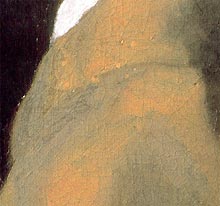
The yellow garment adorning the young girl stands as a distinctive element within Vermeer's body of work. Technically speaking, it likely ranks among the artist's more generalized renderings. The bold, energetic brushstrokes imply rather than precisely outline the weighty folds of what might be interpreted as a cape or an unfitted, rustic attire crafted from a coarse fabric.
In 1950, P. T. A. Swillens proposed an intriguing interpretation of the young girl's attire: "The blue-yellow head covering of the portrait in The Hague and the yellow cape round the shoulders are not usual wear for those times. It is a special dress, which suits children and which children delight in, just because it is unusual and different and attractive in color. Just with such a fancy-dress children betray that they are still childish."
Using a badger brush

Prior to the 1994 restoration, the painting bore aesthetic challenges. The aged layers of varnish had considerably yellowed, necessitating their removal with cotton swabs dipped in solvent. The former varnish is evident on the left-hand side of the above image. Areas of the face that seemed discolored were, in reality, earlier retouches that had flaked off. These aged retouches were eliminated, and the damaged portions underwent restoration to harmonize with the painting's lighter tone.
To achieve the soft transitions in the girl's face, Vermeer likely utilized a badger brush, a fan-shaped flat brush endowed with soft bristles. Also known as sweeteners, badger brushes were employed sparingly during the 17th century but gained popularity among Neoclassical artists who sought the gentlest tonal transitions achievable. This brush is characterized by its fan-shaped design and features soft bristles, typically made from the hair of a badger, which is a type of animal known for its fine and delicate fur. The softness and flexibility of the bristles make it possible to apply and blend paint in a way that minimizes visible brushstrokes and creates a more harmonious and natural appearance.
Badger brushes have historically been utilized by artists to achieve delicate shading and nuanced color variations, especially in techniques like oil painting where achieving smooth transitions between colors can be challenging. They are especially effective when working on surfaces that require fine detail work, such as portraits, where achieving realistic skin tones and soft shadows is crucial.
The turban

Boy in a Turban
Michiel Sweerts
1656–1658
87 x 74 cm.
Museo Thyssen-Bornemisza, Madrid
Like many other Dutch painters, Vermeer adeptly incorporated an exotic note in his paintings, utilizing the opportunity to showcase his technical prowess. However, the type of turban worn by Vermeer's young girl is so unusual that no reasonable comparison has been found in the context of European painting. In the 17th century, a Dutch girl would not have been easily seen wearing a turban. Critics now believe that Vermeer drew his inspiration from art rather than life, specifically from Michael Sweerts' A Boy Wearing a Turban and Holding a Nosegay, an excellent example of the Dutch tronie tradition.
Sweerts' painting dates to circa 1655–1656, about ten years before the Girl with a Pearl Earring was presumably painted. The out-of-the-ordinary garb, the black background (typical of Sweerts) and the curious turban coupled with the distinctive blue/light-yellow color scheme may have indeed struck Vermeer's imagination.

It is possible that the piece of fabric used as a makeshift turban, whatever its practical use may have been, appears in other pictures by Vermeer. Its material and the light-yellow color with a blue border seem comparable to the one seen draping from the still life in The Art of Painting and The Love Letter.
The pearl
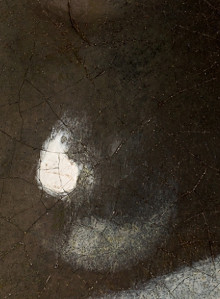
Several years ago, art historian Monique Rakhorst highlighted a 17th-century sketchbook of Thomas Cletcher, a jeweller from The Hague. This sketchbook offers insights into the pearl trade and its high prices. For instance, Cletcher documented buying two large pearls in London in 1632 for a thousand pounds, which he used to craft earrings for Princess Amalia of Solms. Later, he sold a string of twenty pearls to her husband, Frederik Hendrik, for 30,000 guilders. In times the cost of a small house in the Netherlands was roughly 1,000 guilders. Given the exorbitant prices of real pearls, it's certain that the pearls depicted in Vermeer’s paintings were imitation glass pearls, primarily produced by Venetian glassblowers at the time.
The drop pearl worn by the young girl, often referred to as such due to its shape, hangs poised and serene within a receding expanse of space. Its contour and physicality find definition through the substantial white impasto stroke, capturing the very beams of light that sweep across the girl's countenance. Additionally, a gentle reflection captures fragments of light emitted by the white collar situated below. The pearl's oblong configuration imparts a sensation of weight and dimension, qualities that might not be as pronounced with a spherical pearl. It is plausible that a pearl of such dimensions and shape was not a tangible reality, prompting speculation that the artist portrayed an artificial variant or intentionally amplified its proportions. This task was well within the capabilities of an artist as technically adept as Vermeer.

In the 1994 restoration of the painting, the reflection beneath the pearl exhibited a diminutive, radiant highlight that was not, upon scrutiny, integral to the painting's original composition. A meticulous analysis revealed its identity as a paint flake tainted by adjacency to a light-toned filler during a preceding restoration endeavor. Upon successful removal of the flake, the pearl recaptured its initial subtle luminescence.
The possibility arises that the model might have been adorned with an imitation pearl crafted from glass—a technique frequently employed in 17th-century Italy to replicate the allure of genuine pearls.
The dark background
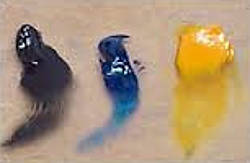
When Vermeer painted the background, it featured a glossy, enamel-like surface of smooth, translucent green. Over time, the dyes have faded and deteriorated, thus diminishing some of this inherent luminosity. Vermeer meticulously layered the background with a twofold approach. Firstly, he delicately applied a thin coat of charcoal black, allowing it to dry. Subsequently, he layered a profound, translucent glaze atop the black layer. This glaze's colorants—indigo (blue) and weld (yellow)—retain their translucence in oil. Other components within the glaze, namely chalk, alum, lead white and a touch of red ochre, contributed minimally to its optical clarity.
However, until recently, the background had been interpreted as a flat dark space. But advanced imaging techniques visualized diagonal lines and color variations that suggest folded fabric in the upper right-hand corner of the painting. The curtain has disappeared over the course of the centuries as a result of physical and chemical changes in the translucent green paint. Thus, the draped fabric would have situated the girl into a more defined space while still drawing the spectator's focus to her brightly-lit face and ochre clothing.
In portraiture, dark backgrounds were frequently employed to accentuate the figure's three-dimensional presence. In fragment 232 of the Treatise on Painting, Leonardo da Vinci astutely observed that a dark background imparts a lighter appearance to an object, and conversely, a light object appears darker.
The girl's flesh
The Girl with a Pearl Earring provides a rich sample of Vermeer’s virtuoso painting technique, in which the surfaces and textures of different motifs are rendered with distinct techniques. The clothing is depicted more schematically and is enlivened with small dots of paint suggesting reflected light called pointillés—one of Vermeer’s trademark features. The artist has clearly indicated differences between materials— for instance, between the white collar, painted in thick impasto, and the drier paint of the turban. The face, instead, is modeled very softly, defining form with gradual transitions and invisible brushstrokes.
What is most surprising about Vermeer's treatment of human flesh is that the flesh tones in many of his works, including those of the Girl with a Pearl Earring, are modeled with surprisingly few colors. The light pink base tone is made from simple admixtures of a fiery red pigment, called vermilion, and white. The deepest shadows are painted more transparently with umber, and perhaps a bit of black. The mid-tones, the values between the lightest and darkest shades, are done with the same base flesh mixture with slight additions of umber, which producesa series of subtle grays. This technique is in significant contrast with most modern palettes for painting flesh, which can be composed of ten or more colors, and add some kind of yellow to the base flesh tone. Vermeer's technique, however, was not exclusive to him, but was adopted by the overwhelming majority of 17th-century painters, which attests to its efficiency.
special topics
- The turkish turban in European painting
- Beautiful women and jewels
- A Fake Pearl?
- Vermeer & the fijnschilder school of art
- A painting made of crushed pearls
- Pricing a masterwork
- Who posed for the painting?
- Sold in 1881 for "next to nothing"
- The painting's signature
- Inspired by an Italian painting?
- An early mentor?
- Listen to period music
fact sheet
- Signature
- Date
- Provenance
- Exhibitions
- Technical description
- Before and after the painting's restoration
- The painting with its frame
- How big is this picture?
- Download High-Resolution Image from the Mauritshuis
- Google Art Project ultra-zoom image
- Historic timeline of the year(s) Vermeer created this painting
- Related artworks
Critical assessment
It is always the beauty of this portrait head, its purity, freshness, radiance, sensuality that is singled out for comment. Vermeer himself, as Gowing notes, provides the metaphor: she is like a pearl. Yet there is a sense in which this response, no matter how inevitable, begs the question of the. painting, and evades the claims it makes on the viewer. For to look at it is to be implicated in a relationship so urgent that to take an instinctive step backward into aesthetic appreciation would seem in this case a defensive, an act of betrayal and bad faith. It is me at whom she gazes, with real, unguarded human emotions and with an erotic intensity that demands something just as real and human in return. The relationship may be only with an image, yet it involves all that art is supposed to keep at bay.
Edward A. Snow, A Study of Vermeer, 1979
The signature

Inscribed top left corner IVMeer (IVM in ligature).
(Click here to access a complete study of Vermeer's signatures.)
Dates
1665
Albert Blankert, Vermeer: 1632–1675, 1975
c. 1665–1666
Arthur K. Wheelock Jr., The Public and the Private in the Age of Vermeer, London, 2000
c. 1665–1667
Walter Liedtke, Vermeer: The Complete Paintings, New York, 2008
c. 1665–1667
Wayne Franits, Vermeer, 2015
(Click here to access a complete study of the dates of Vermeer's paintings).
Technical report
The fine, plain-weave linen support, which has been lined, has a threadcount of 14.7 x 14.3 per cm². Only fragments of the original tacking edges survive.
The composition was laid in with light and dark areas. The ground is a thick, yellowish-white layer containing lead white, chalk and possibly umber.
The dark background and the deeper shadows of the girl's face, turban and bodice were established with a mixture of black and earth pigments and further modeled with a paler, ocher color. The shadow of her nose was underpainted with red lake while the highlights on her nose, right cheek and forehead have a thick, cream-colored underpaint. The turban was painted with varying shades of an ultramarine and lead white mixture; wet-in-wet, over which a blue glaze was applied, except in the highlights. A thin, off-white scumble of paint over the brown shadow of the girl's neck defines the pearl and is painted more opaquely at the bottom where the pearl reflects the white collar. Small hairs from Vermeer's brush are found in the half-tones of the flesh areas.
* Johannes Vermeer (exh. cat., National Gallery of Art and Royal Cabinet of Paintings Mauritshuis - Washington and The Hague, 1995, edited by Arthur K. Wheelock Jr.)
Provenance
- (?) Pieter Claesz. van Ruijven, Delft (d. 1674); (?) his widow, Maria de Knuijt, Delft (d. 1681);
- (?) their daughter, Magdalena van Ruijven, Delft (d. 1682);
- (?) her widower, Jacob Abrahamsz Dissius (d. 1695); Dissius sale, Amsterdam, 16 May, 1696, no. 38, 39 or 40 [tronien];
- Braams sale, The Hague, 1881 (day and month unknown), to Des Tombe;
- Arnoldus Andries des Tombe, The Hague (1881-d.1902);
- 1903 bequest of Arnoldus des Tombe to the Koninklijk Kabinet van Schilderijen Mauritshuis, The Hague (inv. 670).
Exhibitions
- The Hague 1890
Catalogus der tentoonstelling van schilderijen van oude meesters
Pulchri Studio
57, no. 117 - Paris April–May1921
Exposition hollandaise: Tableaux, aquarelles et dessins anciens et modernes
Jeu de Paume
10, no. 106 and ill. - Rome January 5–April 28, 1928
Mostra di capolavori della pittura olandese
Galleria Borghese
100, no. 125 and ill., as "Testa di Fanciulla" - London January 4–March 9, 1929
Exhibition of Dutch Art, 1450–1900
Royal Academy of Arts
145, no. 306 - The Hague 1945
Nederlandsche kunst van de XVde en XVIde eeuw
Mauritshuis
no. 134 - Antwerp 1946
De Hollandsche Schilderkunst van Jeroen Bosch tot Rembrandt. Keuze van Meesterwerken uit Nederlandsche Musea
Koninklijk Museum voor Schone Kunsten
no. 91 and ill. - Delft November–April, 1950
Het Koninklijke kabinet 'Het Mauritshuis' in het museum 'Het Prinsenhof' te Delft
Stedelijk Museum Het Prinsenhof
11, no. 27 - The Hague June 24–September 5, 1966
In het licht van Vermeer
Mauritshuis
no. V and ill. - Paris September 24–November 28, 1966
Dans la lumière de Vermeer
Musée de l'Orangerie
no. VI and ill. - Washington D.C. April 23–October 31, 1982
Mauritshuis, Dutch Paintings of the Golden Age
National Gallery of Art
120–121, no. 38 and ill. - Tokyo April 24–June 10, 1984
Dutch Paintings of the Golden Age from the Royal Picture Gallery
Mauritsuis
110–111, no. 40 and ill., as "Head of a Girl" - Paris February 19–June 30, 1986
De Rembrandt à Vermeer: Les peintres hollandais au Mauritshuis à la Haye
Grand Palais
358–362, no. 54 and ill. - Washington D.C. November 12, 1995–February 11, 1996
Johannes Vermeer
National Gallery of Art
166–169, no. 15 and ill. - The Hague March 1–June 2, 1996
Johannes Vermeer
Mauritshuis
166–169, no. 15 and ill. - Osaka April 4–July 2, 2000
The Public and the Private in the Age of Vermeer
Osaka Municipal Museum of Art
186–189, no. 34 and ill. - Tokyo June 20–September 17, 2012
Masterpieces from the Royal Picture Gallery
Tokyo Art Museum - Kobe October 1, 2012–December 23, 2013
Masterpieces from the Royal Picture Gallery
City Museum Kobe. - San Francisco January 26–June 2, 2013
Masterpieces from the Royal Picture Gallery
M. H. de Young Memorial Museum - Atlanta June 22–September 29, 2013
Masterpieces from the Royal Picture Gallery
High Museum of Art - New York October 22, 2013–January 12, 2014
Masterpieces from the Royal Picture Gallery
The Frick Collection - Bologna February 8–May 25, 2014
La ragazza con l'orecchino di perla: Il mito della Golden Age. Da Vermeer a Rembrandt capolavori dal Mauritshuis
Palazzo Fava - The Hague October 7, 2021–January 9, 2022
Facelifts & Makeovers
Mauritshuis, The Hague - Amsterdam February 10– June 4, 2023
VERMEER
Rijksmuseum
no. 25 and ill.
(Click here to access a complete, sortable list of the exhibitions of Vermeer's paintings).
| Vermeer's life | Pieter van Ruijven and his wife Maria Knuijt leave 500 guilders to Vermeer in their last will and testament. This kind of a bequest is very unusual and testifies a close relationship between Vermeer and Van Ruijven that went beyond the usual patron/painter one. It would seem that in his life-time the rich Delft burger had bought a sizable share of Vermeer's artistic output. |
| Dutch painting |
Rembrandt paints The Jewish Bride. Adriaen van Ostade paints The Physician in His Study. c. 1665 Gerrit Dou painted Woman at the Clavichord and a Self-Portrait in which he resembled Rembrandt. |
| European painting & architecture |
Bernini finishes high altar, St. Peter's, Rome (begun 1656). Murillo: Rest on the Flight into Egypt. Nicolas Poussin, French painter, dies. Known as the founder of French Classicism, he spent most of his career in Rome which he reached at age 30 in 1624. His Greco-Romanism work includes The Death of Chione and The Abduction of the Sabine Women. Compagnie Saint-Gobain is founded by royal decree to make mirrors for France's Louis XIV. It will become Europe's largest glass-maker. Francesco Borromini completes Rome's Church of San Andrea delle Fratte. |
| Music |
Molière: Don Giovanni. Sep 22, Moliere's L'amour Medecin, premiered in Paris. |
| Literature |
Philosophical Transactions of the Royal Society begins publication. |
| Science & philosophy |
Giovanni Cassini determines rotations of Jupiter, Mars and Venus. Peter Chamberlen, court physician to Charles 11, invents midwifery forceps Pierre de Fermat, French mathematician, dies. His equation xn + yn = zn is called Fermat's Last Theorem and remained unproven for many years. The history of its resolution and final proof by Andrew Wiles is told by Amir D. Aczel in his 1996 book Fermat's Last Theorem. Fermat's Enigma: The Epic Quest to Solve the World's Greatest Mathematical Problem by Simon Singh was published in 1997. In 1905 Paul Wolfskehl, a German mathematician, bequeathed a reward of 100,000 marks to whoever could find a proof to Fermat's "last theorem." It stumped mathematicians until 1993, when Andrew John Wiles made a breakthrough. Francis Grimaldi: Physicomathesis de lumine (posth.) explains diffraction of light. Isaac Newton experiments on gravitation; invents differential calculus. Robert Hooke's Micrographia, with illustrations of objects viewed through a microscope, is published. The book greatly influences both scientists and educated laypeople. In it, Hooke describes cells (viewed in sections of cork) for the first time. Fundamentally, it is the first book dealing with observations through a microscope, comparing light to waves in water. Mathematician Pierre de Fermat dies at Castres January 12 at age 63, having (with the late Blaise Pascal) founded the probability theory. His remains will be reburied in the family vault at Toulouse. |
| History |
English naval forces defeat a Dutch fleet off Lowestoft June 3 as a Second Anglo-Dutch war begins, 11 years after the end of the first such war. General George Monck, 1st duke of Albemarle, commands the English fleet, Charles II bestows a knighthood on Irish-born pirate Robert Holmes, 42, and promotes him to acting rear admiral, giving him command of the new third-rate battleship Defiance, but the Dutch block the entrance to the Thames in October Feb 6, Anne Stuart, queen of England (1702–1714), is born. At least 68,000 Londoners died of the plague in this year.
The second war between England and the United Provinces breaks out. It will last until 1667 and devastate the art market. Mar 11, A new legal code was approved for the Dutch and English towns, guaranteeing religious observances unhindered. Nov 7, The London Gazette, the oldest surviving journal, is first published. Ceylon becomes important trade centre for the VOC |
| Vermeer's life |
The Concert presents a very similar deep spatial recession similar to the earlier Music Lesson. Vermeer's interest in the accurate portrayal of three dimensional perspective to create such an effect was shared by other interior genre painters of the time, however, only Vermeer seems to have fully and consciously understood the expressive function of perspective. The two paintings' underlying theme of music between male and female company is also analogous although few critics believe they were conceived as a pendant. In the paintings of the 1660s the painted surfaces are smoother and less tactile, the lighting schemes tend to be less bold. These pictures convey and impalpable air of reticence and introspection, unique among genre painters with the possible exception of Gerrit ter Borch. |
| Dutch painting | Frans Hals, eminent Dutch portrait painter, dies. It was formerly believed that he died in the Oudemannenhuis almshouse in Haarlem which was later became the Frans Halsmuseum. |
| European painting & architecture |
François Mansart, French architect, dies. Apr 9, 1st public art exhibition (Palais Royale, Paris). |
| Music | Dec 5, Francesco Antonio Nicola Scarlatti, composer, is born. |
| Literature | Le Misanthrope by Molière is palyed at the Palais-Royal, Paris. |
| Science & philosophy |
Laws of gravity established by Cambridge University mathematics professor Isaac Newton, 23, state that the attraction exerted by gravity between any two bodies is directly proportional to their masses and inversely proportional to the square of the distance between them. Newton has returned to his native Woolsthorpe because the plague at Cambridge has closed Trinity College, where he is a fellow; he has observed the fall of an apple in an orchard at Woolsthorpe and calculates that at a distance of one foot the attraction between two objects is 100 times stronger than at 10 feet. Although he does not fully comprehend the nature of gravity, he concludes that the force exerted on the apple is the same as that exerted on Earth by the moon. Calculusis invented by Isaac Newton will prove to be one of the most effective tool for scientific investigation ever produced by mathematics. Nov 14, Samuel Pepys reported the on first blood transfusion, which was between dogs. The plague decimates London and Isaac Newton moved to the country. He had already discovered the binomial theorem at Cambridge and was offered the post of professor of mathematics. Newton formulates his law of universal gravitation. A French Academy of Sciences (Académie Royale des Sciences) founded by Louis XIV at Paris seeks to rival London's 4-year-old Royal Society. Jean Baptiste Colbert has persuaded the king to begin subsidizing scientists. Christiaan Huygens, along with 19 other scientists, is elected as a founding member. After the French Revolution, the Royale is dropped and the character of the academy changes. It later becomes the Institut de France. |
| History |
Sep 2, The Great Fire of London, started at Pudding Lane, began to demolish about four-fifths of London when in the house of King Charles II's baker, Thomas Farrinor, forgets to extinguish his oven. The flames raged uncontrollably for the next few days, helped along by the wind, as well as by warehouses full of oil and other flammable substances. Approximately 13,200 houses, 90 churches and 50 livery company halls burn down or explode. But the fire claimed only 16 lives, and it actually helped impede the spread of the deadly Black Plague, as most of the disease-carrying rats were killed in the fire. Because almost all European paper is made from recycled cloth rags, which are becoming increasingly scarce as more and more books and other materials are printed, the English Parliament bans burial in cotton or linen cloth so as to preserve the cloth for paper manufacture. |
| Vermeer's life |
Vermeer's name is mentioned in a poem by Arnold Bon in Dirck van Bleyswijck's Beschryvinge der Stadt Delft (Description of the City of Delft) published in 1667. It is the most significant and direct reference to Vermeer's art to be found. The poem written by Arnold Bon, Bleyswyck's publisher, was composed in the honor of Carel Fabritius who had died in the famous ammunitions explosion. Vermeer's name is lauded in the poem's last stanza.
Maria Thins empowers Vermeer to collect various debts owed to her and to reinvest the money according to his will and discretion. Vermeer's mother-on-law evidently maintained her moral and financial support of Vermeer and his family. Another of Vermeer's children is buried in the New Church in Delft. |
| Dutch painting | Gabriel Metsu, ecclectic Dutch painter, dies. |
| European painting & architecture |
Francesco Borromini, Italian sculptor and architect, dies. Borromini designed the San Ivo della Sapienza church in Rome. Alonso Cano, Spanish painter and architect, dies. |
| Music | German composer-organist-harpsichordist Johann Jakob Froberger dies at Héricourt, France. His keyboard suites will be published in 1693, arranged in the order that will become standard: allemande, courante, sarabande and gigue. |
| Literature |
Paradise Lost is written by John Milton, who has been blind since 1652 but has dictated to his daughters the 10-volume work on the fall of man, Better to reign in Hell than serve in Heaven. Milton's Adam questions the angel Raphael about celestial mechanics, Raphael replies with some vague hints and then says that "the rest from Man or Angel the great Architect did wisely conceal and not divulge His secrets to be scann'd by them who ought rather admire." The work enjoys sales of 1,300 copies in 18 months and will be enlarged to 12 volumes in 1684, the year of Milton's death; Annus Mirabilis by John Dryden is about the Dutch War and last year's Great Fire. Nov 7, Jean Racine's Andromaque, premiered in Paris. |
| Science & philosophy | National Observatory, Paris, founded |
| History | Pope Alexander VII dies. Giulio Rospigliosi becomes Pope Clement IX.
c. 1667 In France, during the reign of King Louis XIV, the fork begins to achieve popularity as an eating implement. Formerly, only knives and spoons had been used. Jun 18, The Dutch fleet sailed up the Thames and threatened London. They burned 3 ships and capture the English flagship. Jun 21, The Peace of Breda endsthe Second Anglo-Dutch War (1664–1667) and sees the Dutch cede New Amsterdam (on Manhattan Island) to the English in exchange for the island of Surinam. De Verstandige Kok (The Sensible Cook) is published for the first time. Geared towards middle- and upper middle-class families, the book advises a regular and balanced diet, including fresh meat at least once a week, frequent servings of bread and cheese, stew, fresh vegetables and salads. While simple dishes, such as porridge, pancakes and soup with bread are eaten by all classes, studies reveal that only the affluent have regular access to fresh vegetables during the period; the less wealthy depend on dried peas and beans. |
The Turkish turban in European painting
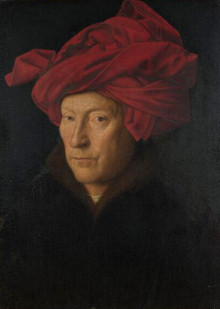
Man in a Turban
Jan van Eyck
1433
25.5 x 19 cm.
National Gallery, London
The emergence of the young girl's turban in the context of Vermeer's seemingly quintessential Dutch oeuvre should not be utterly unexpected. Other items of "Turkish" origin can be associated with the artist. Certain carpets, which appear as table coverings—uncommonly rendered as such by contemporary painters—derive from Turkish roots. These carpets must have garnered admiration for their evocative floral motifs and the substantial infusion of warm red hues, infusing vitality into the otherwise geometric and cool interiors.
However, one should not hastily assume that anything dubbed "Turkish" in historical records truly hailed from that country. The term was employed loosely to encompass exotic imports that enjoyed popularity. Notably, in the inventory dated 29 February 1676, compiled shortly after the artist's passing, we encounter entries like "a Turkish mantle of the aforesaid Sr. Vermeer," "a pair of Turkish trousers," and "a black Turkish mantle," all located in the "great hallway" of his residence. Some scholars posit that the two "tronien" depicted in "Turkish dress," found in the kitchen, might conceivably be attributed to Vermeer's brush.
During the Renaissance and Baroque periods, turbans were frequently used to convey exoticism and orientalism. Artists depicted characters in "Turkish" attire, including turbans, to evoke a sense of the foreign and the unknown. These depictions were not always accurate representations of actual Turkish clothing but were used as visual devices to add an element of intrigue and allure. In 17th-century Dutch art, turbans were often used to signify wealth, luxury and a connection to global trade. Paintings by artists such as Jan Steen, Michael Sweerts, Jan Lievens and Rembrandt featured characters wearing turbans as a testament to their social status and access to exotic goods often adorned with jewels and fine fabrics.
A painting made of crushed pearls
Vermeer's women are frequently associated to the pearls adorning them, to the extent that his body of work has become synonymous with this jewel. In 1938, Jan Veth, a a Dutch painter, art historian, critic, writer and. a prominent figure in the Dutch art scene during the late 19th and early 20th centuries, echoed a prevalent sentiment when he observed the Girl with a Pearl Earring: "More than with any other VERMEER, one could say that it looks as if it were blended from the dust of crushed pearls." During the 17th century, pearls held significant status as symbol.
Who posed for the painting?

Upon careful examination of the Girl with a Pearl Earring, an intriguing inquiry arises regarding the extent to which the painting can be interpreted as a portrait. P. T. A. Swillens, a Dutch art historian, author and expert on the works of Vermeer who meticulously compiled the first comprehensive study of the artist's life and work in 1950, underscored a crucial attribute of 17th-century portraiture: the element of likeness. However, though the judgment of her appearance has dimmed with time, the girl, in an aesthetic context, wouldn't be hailed as a conventional beauty. Swillens notes that Vermeer deliberately abstained from idealizing her visage.
Contemporary scholars remain divided on this subject. Arthur K. Wheelock Jr. posits that the painting serves as an "idealized study," exposing Vermeer's "classical tendencies."
None of the sitters depicted in Vermeer's existing paintings have been conclusively identified, including the young girl featured in the Girl with a Pearl Earring. Some critics speculate that she might have been Vermeer's first daughter, Maria, who would have been approximately 12 or 13 years old during the years 1665–1667, a period specialists have assigned to the creation of the painting. Nonetheless, it's imperative to recognize that this artwork does not conform to the 17th-century notion of a portrait; rather, it is a tronie. Irrespective of the identity, she bears a resemblance to the model portrayed in Vermeer's Art of Painting.
Sold in 1881 for "next to nothing"
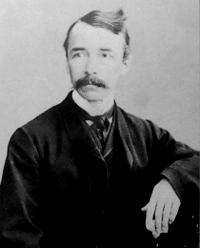
Arnoldus Andries des Tombe
The Girl with a Pearl Earring reemerged in the Netherlands 300 years after it left the artist's studio. Shortly after it was sold for next to nothing.
The history of the acquisition of the Vermeer has by now become legendary. In 1881 Arnoldus Andries des Tombe purchased Vermeer's Girl with a Pearl Earring at a sale at the Venduhuis der Notarissen in the Nobelstraat in The Hague for 2 guilders with a 30 cent premium. Unfortunately, the invoice, which was given to the Mauritshuis in 1944, has disappeared without a trace. Thanks to a notice in the former daily newspaper Het Vaderland of 3 March 1903, in which the bequest was made public (pasted in the Mauritshuis' cuttings album), we know that Victor de Stuers had recognized the painting as a work by Vermeer. De Stuers was Des Tombe's neighbor—his collection in his residence at 24 Parkstraat was also open to all interested parties—and the two gentlemen had gone together to the auction preview. Des Tombe and De Stuers agreed not to bid against each other. After its acquisition, the badly neglected canvas was sent to Antwerp, where it was "restored" by the painter Van der Haeghen. In the Des Tombe family, however, the story was that Des Tombe and his friend De Stuers had seen a painting that "seemed rather beautiful but was too dirty to evaluate properly." In this version, it was only after the picture had been cleaned that the signature became visible, making clear the identity of the painter.
After Des Tombe's death on 16 December 1902 (his wife had died the year before and their marriage had remained childless) it turned out that he had secretly bequeathed 12 paintings to the Mauritshuis, including Vermeer's famous Girl with a Pearl Earring.
(from Quentin Buvelot, "Collecting History: On Des Tombe, Donor of Vermeer's 'Girl with a Pearl Earring'" in the Mauritshuis Bulletin, volume 17, no. 1, March 2004)
The painting's signature

Vermeer used several signatures throughout his career, but the placement and style of this one is most similar to the Study of a Young Woman from the Metropolitan Museum. The signature of the Girl with a Pearl Earring resides in the upper left corner. Executed with a lighter-toned pigment atop the dark background, it is faint enough that it often escapes the notice of many viewers, and in reproductions, it remains scarcely discernible. Vermeer employed similarly light-toned signatures in his other works too. This style aligns with the artist's approach to signature placement. While the signature is almost invisible with the naked eye, it be plainly an see it in the calcium (Ca) map made by MA-XRF.
Inspired by an Italian painting?
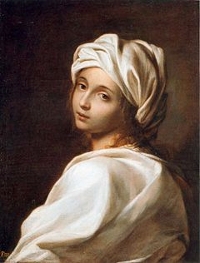
Beatrice Cenci
attributed to Guido Reni
1599
64.5 x 49 cm.
Galleria Nazionale d'Arte Antica, Rome
While some of Vermeer's works have easily traceable thematic and compositional origins, others present more intricate challenges. The possibility remains that even a seemingly straightforward motif like the Girl with a Pearl Earring could have been independently conceived.
Nevertheless, scholars specializing in Vermeer's art have put forth an array of potential Dutch and foreign models. Notably, there's the traditional consideration of the Italian painter Guido Reni's Beatrice Cenci.* While this association might initially appear tenuous, it's important to acknowledge that Vermeer was indeed familiar with the Beatrice Cenci narrative, which had captivated the collective imagination of Europe. It's conceivable that he encountered copies of Reni's original painting or engravings that were widely circulated across the continent.
Beatrice, the daughter of the affluent and influential Francesco Cenci, endured her father's brutal mistreatment. Francesco, marked by violence and moral degradation, subjected both Beatrice and her stepmother to captivity within the Castle of Petrella Salto, near Rieti. Eventually, driven to despair by his relentless abuse, Beatrice, with the cooperation of her stepmother and two brothers, orchestrated her father's murder in 1598. Subsequently, after a trial that held the attention of Rome's populace, she was sentenced to death by order of Pope Clement VIII. It's speculated that the Pope's motivation could have been driven by the desire to seize the family's assets. In September of 1599, amidst a sizable crowd, Beatrice was executed by decapitation on the Ponte Sant'Angelo, instantly transforming into an emblem of oppressed innocence.
There exists a hypothesis that the prominent Italian painter Caravaggio was present during Beatrice's decapitation, an event that potentially inspired his work Judith Cutting off the Head of Holofernes. Caravaggio's masterful depiction, characterized by precise and realistic anatomical and physiological details, suggests an intimate familiarity with the actual process of decapitation.

Mary Magdalene (detail)
Jan van Scorel
c. 1530
Oil on panel, 67 x 76.5 cm.
Rijksmuseum, Amsterdam
Notably, Lawrence Gowing, a significant authority on Vermeer, has proposed the influence of Jan Scorel's female portraits. However, both the influences of Scorel and Reni have somewhat receded in favor of connections that are relatively less exotic, particularly those with the Dutch painter Michiel Sweerts.
It's worth noting that the attribution of the Beatrice Cenci to Reni has been contested due to its lesser quality compared to his other works. Many critics have questioned its authenticity as an autograph work by Reni, suggesting that it might have been executed by an artist within Reni's immediate circle, potentially Elisabetta Sirani, known for capturing the master's models in a condensed and simplified manner.
Listen to period music
![]() Johann Sebastian Bach
Johann Sebastian Bach
Concerto for Harpsichord and Strings f-Minor, BWV 1056, Largo [1.89 MB]
http://www.amazon.de/Cembalowerke-Pischner-Sanderling-St%C3%A4dt-Beso/dp/B000025H6D
Beautiful women and jewels

Portrait of Maria Louisa de Tassis (detail)
Anthony van Dyck
c. 1629/30
129 x 93 cm.
Grand Ducal Collection, Vaduz, Liechtenstein
Art historian Robert Baldwin aptly notes the existence of a "tradition of comparing beautiful women to jewels. Within courtly culture, these women assumed a quality akin to that of precious jewels, radiating a brilliance that transcended mere material opulence. This symbolic transformation mirrored the spiritual significance attributed to jewels in Christian depictions of the divine, their luminous allure pointing toward celestial beauty. This sentiment is echoed in European courtly poetry, where women were often likened to jewels or lauded as surpassing the splendor of even the most exquisite gems.
Vermeer, however, distinguished himself by moving beyond the realm of ostensible material allure. Unlike the lavish use of jewels in courtly portraits and portrayals by artists such as Van Dyck and Mignard, Vermeer's approach was characterized by restraint. He intentionally limited his palette to a simple pearl, eschewing the extravagance of rubies, sapphires and diamonds. More significantly, Vermeer's masterful technique involved employing a cool, silvery color scheme and applying layered, translucent oil glazes. This meticulous process dissolved the boundaries of material reality, instilling his works with a pearl-like luminosity. In this visual transformation, Vermeer's depictions of beautiful women, adorned with pearls, mirrored the familiar aesthetic of contemporary love poetry. Here, the external allure seamlessly dissolved into an inner radiance, reflecting a nuanced interplay between outer and inner beauty.
Vermeer & the fijnschilder school of art
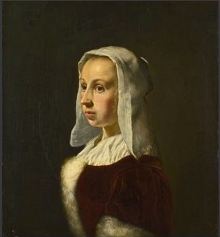
Portrait of the Artist's Wife, Cunera van der Cock
Frans van Mieris the Elder
c. 1657–1658
16 x 13.3 cm.
National Gallery, London
Although this portrait by the fijnschilder (fine painter) Frans van Mieris has been associated with the Girl with a Pearl Earring, few works exemplify the profound contrasts in artistic methods and objectives that set Vermeer apart from his contemporaries. While Vermeer shared a common reservoir of motifs with the fijnschilder style, he cannot be easily categorized as a staunch adherent to their meticulously detailed approach. The fijnschilders' fervent pursuit of minutiae in their artistry diverged markedly from Vermeer's detached exploration of light dynamics and pictorial design intricacies, which have come to define his oeuvre.
Despite the intricate appearance of Vermeer's compositions to modern-day viewers, his painting technique stands in contrast to the microscopic precision championed by this school. Vermeer's modeling is characterized by a more generalized approach, evident in the enigmatic fabric of the girl's yellow attire that has eluded definitive identification. In contrast, Van Mieris' painting meticulously renders individual hairs of fur trim, ensuring meticulous recognition. Such intricate rendering compels observers to scrutinize each detail up close, while Vermeer's approach encourages a step back, inviting viewers to engage with the entirety of the image.
The fijnschilder style had ventured to such extremes because aspiring artists constantly vied to surpass their mentors in crafting the most compelling illusion of surface textures.
Interestingly, the fijnschilder movement emerged during a period when the Dutch art market faced contraction due to economic downturn and was further hampered by the war with France. The once-thriving art market found itself saturated with affordably priced works by contemporary artists and those of past generations re-entering circulation upon their original owners' passing. Rather than adapting strategies to expedite production and outpace competition, fijnschilders took a divergent approach, investing unprecedented time and effort into each work, often on a diminutive scale. These artists targeted the preferences and budgets of the affluent bourgeoisie, whose prosperity remained largely unscathed by the economic crisis and, if anything, had flourished.
Considering this context, it is conceivable that Vermeer's essential "simplicity" and compositional restraint may not have garnered full appreciation within the prevailing taste for fijnschilder art. While Vermeer's talent was acknowledged by connoisseurs of the elite, he did not attain the international renown or the prices commanded by his peers.
Pricing a masterwork
Given its present iconic status, it may be surprising to learn that the Girl with a Pearl Earring remained hidden from public view until 1881, enduring 200 years of neglect. Although Vermeer's name had faded from mainstream art history, some of his notable works still held their ground in significant European art collections, despite a few being erroneously attributed to other painters to enhance their value.

The Young Mother
Gerrit Dou
1658
73.5 x 55.5 cm.
Mauritshuis, The Hague
In the 17th century, artworks were perceived through a different lens than today. Primarily, the Girl with a Pearl Earring was not regarded as a portrait but as a tronie—a distinct type of bust-length figure that prioritized capturing the buyer's attention over revealing the sitter's personal identity. Tronies were created for the open market and sold in considerable quantities at affordable prices. Interestingly, a painting's value was often determined not solely by its aesthetic appeal or the artist's reputation. The hierarchical significance of the subject matter held substantial weight, positioning tronies like the Girl with a Pearl Earring on the lower echelons of artistic hierarchy, not far removed from landscapes and the lowest category, still life.
This perspective is mirrored in the relatively modest price that the Girl with a Pearl Earring might have commanded in the 1696 Amsterdam auction featuring 21 Vermeer paintings. Some scholars speculate that it might correspond to "a tronie in antique dress, uncommonly artful," which sold for 46 guilders—a meager sum compared to equally sized works like the Milkmaid or the Woman Holding a Balance, which fetched 175 and 155 guilders respectively. Nevertheless, it is plausible that it was another tronie from the same auction, sold for a mere 17 guilders. Johan Larson, a sculptor from Hague/London, was known to possess another Vermeer tronie valued at just 10 guilders. Reflecting the genre's status, a Rembrandt tronie was purchased for a mere 7 guilders in the same auction alongside the two Vermeers.
A fake pearl?
The substantial size of the "drop" pearl adorning the young girl raises doubts about its authenticity, leaning either toward being a counterfeit or a creation of the artist's imagination. During that era, imitation pearls were manufactured, democratizing access to what was once a luxury worn only by royalty. Various techniques were employed for this purpose.
In ancient times, the Romans coated glass beads with silver and subsequently layered them with glass once again. To achieve the characteristic iridescence of natural pearls, combinations of substances like powdered glass and egg whites, or a mixture of shells and fish scales, were utilized. At times, mother-of-pearl protrusions were meticulously shaped and polished. The art of Venetian glassmakers in crafting artificial pearls reached such heights that by the 16th century, Venetian pearl merchants inflicted severe penalties on those found counterfeiting pearls. Recipes from that era described creating synthetic white pearls from a paste based on talc or alum. Leonardo da Vinci even recommended softening small seed pearls with lemon juice, forming a paste with egg white that could be molded and, once dried, polished on a small lathe.

Ablette
One particularly successful method was pioneered by the French rosary maker M. Jacquin. As the story goes, Jacquin observed a film of silver particles on the water's surface in a container soaking fish called "ablette" or bleak. Collecting and dehydrating these particles, he produced an iridescent powder that he speculated could serve as a pigment. He ventured into crafting faux pearls, conducting initial trials that led to a crucial revelation. When applied to the exterior of glass beads, body heat and sweat caused the coating to dissolve. Yet, injecting the mixture into a hollow glass bead, allowing it to drain from a second hole, proved effective. The bead was then filled with wax to achieve the desired weight. This technique remained a closely guarded secret until 1716, when the renowned French naturalist M. de Réaumur managed to replicate the manufacturing process. The concept of cultured pearls was patented in 1916.
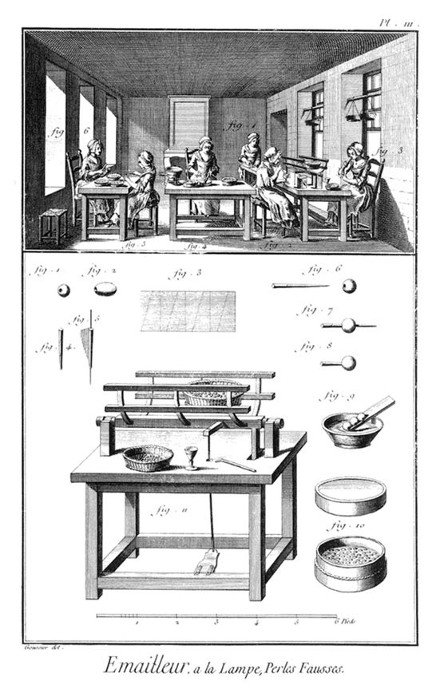
A plate from Diderot's Encyclopédie showing faux pearl manufacturing
cool due
With the publication of the catalogue of the 2023 Vermeer retrospective at the Rijksmuseum, a number of unthought-of hypotheses concerning Vermeer's early career have emerged from an attentive reading of known documents. One, in particular, concerns the influence that the Jesuit Cornelis Daemen Rietwijck, his former neighbor down the street from the Vliegende Vos, the elder Vermeer’s inn on the Voldersgracht, might have had on the early formation of Vermeer's artistic direction.
One of the curators of the exhibition and authors of the catalogue wrote that like many of his contemporaries, historical records concerning Vermeer's training as a painter remain elusive. It is presumed that the young Johannes acquired the foundational skills of the craft after his family relocated to the Markt. John Michael Montias, an American Vermeer biographer, proposed the intriguing possibility that he might have initially attended a nearby school for reading and writing before enrolling in the small academy led by Rietwijck. This Catholic portraitist operated a drawing school just a few houses away from De Vliegende Vos. Here, young learners not only received instruction in the fundamental principles of painting, including drawing from prints, drawings and plaster models, but also obtained basic education in subjects like mathematics. Rietwijck's library encompassed a range of materials, from devotional literature and travel books to historical descriptions, including a copy of Karel van Mander's 1604 work Het schilderboeck (The Book of Painters), which served as a painter's essential guide during those times.
An unaddressed similarity between Vermeer and Rietwijck lies in their shared fascination with tronies. Around the years 1664-1667, Vermeer produced at least four tronies, while the estate inventory of Rietwijck's house, compiled shortly after his passing, recorded around seven by artists like Carel Fabritius and Samuel van Hoogstraten. Rietwijck's shop inventory, upon his death in 1660, listed over seventy character and study heads of varying sizes, which were likely crafted in his studio on the Voldersgracht. This substantial output established him as a leading producer of this prevalent genre in Delft and its surrounding areas during the 17th century. Consequently, it becomes plausible that Vermeer's intrigue with tronies, eventually yielding the renowned Girl with a Pearl Earring, could have been initiated in the studio of his former neighbor Rietwijck as early as the 1640s.

